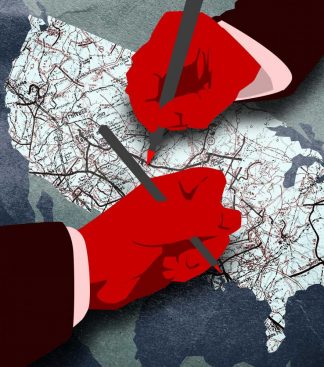By Maggie Parra
Libraries Civic Engagement Committee
The U.S. Congress and state legislatures elect their members to represent smaller districts that segment the state’s population. Following the collection and release of Census data every 10 years, states must redraw the boundaries of congressional and legislative districts to account for population change and balance them for equal population and other criteria.
The 2020 Census was completed in April 2020, at which time the U.S. Census Bureau announced that Minnesota would maintain its eight congressional seats by a very slim margin, which was unchanged from the 2010 census. Each of Minnesota’s eight congressional districts elects one member to the U.S. House of Representatives. For the state Legislature, Minnesota has 67 senate districts that each elect one member to the state Senate. These are each divided into two House districts (134 total) that also elect one member to the state House.
The process
In Minnesota, congressional and state legislative district boundaries are drawn by the Minnesota State Legislature. This requires both houses of the Legislature to pass a bill, and the governor to sign and approve it.
Currently, there is a party division splitting control of the Minnesota Legislature, where the Senate majority is led by the Republican party and the House and Governor’s office are led by the Democratic party. This is not a unique situation for Minnesota. According to the History of Minnesota Legislative Redistricting and the History of Minnesota Congressional Redistricting by Alexis C. Stangl and Matt Gehring, this has been the legislative divide every redistricting year back to 1960.
In the case that the state Legislature is unable to come to consensus on the passing of the redistricting bills, the task instead falls to the courts. Following a 2021 lawsuit authored by a group of Minnesota Democratic voters and the League of Women Voters of Minnesota, Wattson v. Simon, state Supreme Court Chief Justice Lorie Gildea appointed a five-judge Special Redistricting Panel to oversee redistricting in place of the legislature. The panel consisted of two state court of appeals justices and three state district court judges. This is the sixth decade in a row that the courts have assumed responsibility over the redistricting process in Minnesota.
Beginning in October 2021, the court-appointed Special Redistricting Panel held a series of 10 public hearings to gather advice on redrawing political boundaries to reflect 2020 census data. In November 2021, the panel filed the Order Stating Preliminary Conclusions, Redistricting Principles and Requirements for Plan Submissions, which describes the statutory deadline for the legislature to pass the redistricting legislation and secure the governor’s signature by Feb. 15, 2022; otherwise, the court would draw the districts. This order also describes the guiding principles for the drawing of the maps:
- Each district should contain equal numbers of residents, or as close as is possible.
- Districts must be contiguous. This excludes boundaries that connect two different cities with a thin corridor of rural land in between them.
- Districts can’t be drawn to infringe the voting rights of racial or ethnic minority groups, or to divide Native American reservations more than is necessary.
- Political subdivisions like counties or cities should be preserved where possible.
- So-called “communities of interest” should be kept together where possible. This means that areas that share similar “social, geographic, cultural, ethnic, economic, occupational, trade, transportation, or other interests” should be placed in a single district — rather than, say, districts that mix up parts of urban Minneapolis with rural farmland.
- Districts should be as compact as possible.
- Districts shouldn’t be drawn with the intention to promote or harm any party, or to promote or harm the interests of particular politicians. They won’t consider in either way where current officeholders live — either to prevent two incumbents from being drawn into the same district, or to intentionally do so. The judges rejected the idea that they should deliberately draw a map that reflects the state’s partisan balance, in favor of ignoring politics as a formal factor.
Three political party caucuses in the State Legislature and four citizen groups released redistricting proposals that were presented in front of the Special Redistricting Panel in January 2022. The citizen-led intervenors include representatives of communities of color, groups with ties to the state’s two main political parties, and another group led by citizen redistricting and elections experts. By Feb. 15, the Legislature was unable to agree on a redistricting bill and the Special Redistricting Panel released its redistricting plans and issued an order adopting the final maps.
The maps
After the panel issued their order, Briana Bierschbach and Hunter Woodall wrote in the Star Tribune, “Under the new maps, the eighth Congressional district grew larger geographically to accommodate population declines in many rural counties.” According to Tim Pugmire and David Montgomery with MPR, “the new legislative maps push more districts toward the metropolitan area and will pit multiple incumbents against each other… Elections following redistricting tend to produce heavy turnover in the Legislature. Already, dozens of incumbents say they’ll leave their current seats, either to retire or to seek a different office.”
For an analysis of the demographic and partisan breakdown of Minnesota’s new congressional districts, see FiveThirtyEight. A comparison of the 2012 and 2022 maps is provided by Tim Pugmire and David Montgomery with MPR. Interactive maps for both the Congressional and Legislative districts are available on Ballotpedia.
Additional resources:
See the Overview of Reapportionment and Redistricting in Minnesota guide by the Minnesota Legislative Reference Library for more reports about the history of the process.
Ballotpedia. “Redistricting in Minnesota”
Hargarten, Jeff, et al. “Maps Show How Redistricting Reshapes Political Boarders.” Star Tribune, February 15, 2022.
Mohr, Jonathan. “Minnesota’s Redrawn Legislative, Congressional Maps Unveiled.” Session Daily, February 15, 2022.
Montgomery, David. “What you need to know about redistricting in Minnesota”. MPR, February 11, 2022.





